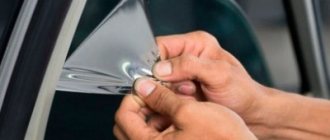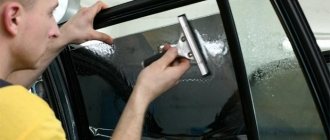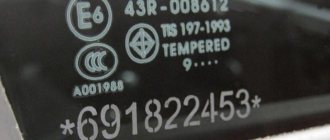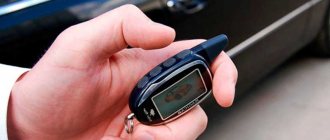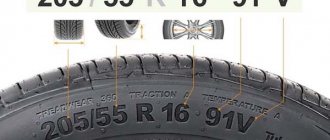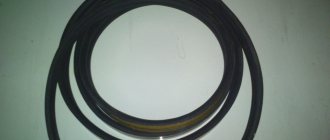Author: Evgeny Zhivoglyadov. Date of publication: June 29, 2016. Category: Automotive equipment.
Car window tinting is not only about appearance chic and the desire to stand out. Various types of car tint films are in demand today for many other reasons, for example, when a car owner wants to hide from the eyes of intruders the equipment in the car or just a bag that was left in a hurry.
In addition, the procedure for applying tint is relatively inexpensive, and thanks to various methods for installing darkening, you can do it yourself. The main thing is to adhere to current standards and GOSTs regarding such external changes. There are not many of them, so remember:
- Mirror tint cannot be installed on a car. Moreover, no matter how your friends convince you, this applies to any fragments of glass. Read more about the ban in the relevant document (GOST 5727-88).
- The degree of tinting on the windshield should not exceed 25%.
- The degree of tinting on the front windows should be no more than 30%.
Healthy! To measure this data, a special device is used - a taumeter.
At the same time, there are no standards for rear windows; there is only one condition - 2 rear-view mirrors must be installed.
Before you decide which tint is best for your car, it’s worth talking about the general advantages of this popular procedure.
What is window tinting?
To darken the glass, a special film or coating is applied to it. The effect will depend on its quality, degree of darkening and materials of manufacture. Many drivers apply tint film for beauty and to change the appearance, but there are other benefits as well. First of all, this is the darkening of the interior. Covers the interior of the car from prying eyes and lets in less sunlight in hot weather. The film also affects the strength of the glass to some extent. When hit, it will not shatter and will maintain its integrity.
Car window tinting
But you should be careful when choosing a film. Failure to comply with light transmission requirements may result in a fine from the traffic police. You also need to understand that tinting still impairs the transparency of the glass.
Responsibility for violation
The light transmittance of the car is regulated by Article 12.5 of the Administrative Code. Responsibility for violation of norms is provided in the form of a fine. For any violation detected, you will have to pay 500 rubles.
There are no preventive measures in the form of warnings or requirements for eliminating deficiencies.
- When paying a fine within 20 days through State Services, a 50% discount is provided.
- For repeated violation of this norm, no clear fine has been established for July 2022.
It is expected that amendments will soon be approved, which provide for a twofold increase in the amount in the event of repeated detection of deficiencies and a sixfold increase in this figure for subsequent violations.
Types of tinting
Tinting can be roughly classified according to three parameters:
- degree of darkness;
- type of film;
- installation method.
Let's look at these points in more detail.
By degree of darkness
When choosing the darkening level, the car owner must rely on GOST 32565-2013 from 2015. It defines the rules of application, the permitted degree of shading and materials.
At the same time, there are different requirements for tinting the windshield, side and rear windows.
The transparency of the windshield according to GOST must be at least 75% or higher. In turn, car glass without any stickers or paint transmits 90-95% of light. This means that even weak tinting of the windshield is unacceptable. Film or paint will reduce light transmittance to prohibited levels. It is permissible to darken only the upper part of the windshield in the form of a narrow strip so that bright sunlight does not blind the driver’s eyes.
The figure below shows the transparency of the glass depending on the degree of darkness.
Transparency of glass by degree of darkness
The transparency of the front side windows must be at least 70%. This is only 5% lower than the windshield. Even this level does not allow the use of dark film. Often the tint already comes from the factory as a clear film or coating. It also affects light transmittance. This means that the dimming resource has already been used.
According to GOST, the car owner can tint the rear and rear side windows if desired. In this case there are no restrictions. Film and other shading media can be used at any level of transparency. This will not be a violation of the law.
By film type
Factory
Many automakers take into account the wishes of their customers, including tinting. Only at the factory they do not use film for this, but special finely dispersed paint. It is applied to glass under certain conditions. This coating is not subject to external influences and scratches. It will be impossible to remove such a darkening. A service station can also perform similar work, but the quality will be much worse. The process requires certain technologies.
Regular
The most common and affordable method of darkening. There are many films on the market with different levels of transparency and color. It has a limited resource of 1-2 years and can fade in the sun.
Athermal
This film is a clear coating with a slight purple tint. It is not very noticeable on the glass, but has a number of advantages and performs a protective function. This coating absorbs most of the ultraviolet spectrum, protecting against heat and sunlight. Athermal film can transmit up to 85% of sunlight, which makes it possible to apply it to side windows and windshields. There are different types of athermal film with different levels of light transmission. The main thing is that the coating meets GOST standards.
Athermal tinting
Chameleon
Chameleon coating is also a type of athermal tinting. It changes the level of light transmission depending on the light level.
Mirror
This coating contains metal particles, which creates a mirror effect. There are also films with varying degrees of specularity and color. The problem is that such coverage is prohibited (windshield and side windows) and problems with the traffic police are inevitable. At night, mirror tinting reflects the light of the headlights, which can potentially lead to an emergency on the road.
Colored
Chosen more for beauty. The color of the film is matched to the color of the car body. Creates a cohesive look and design. There are many shade levels to choose from.
Art tinting
It differs from a simple tint film by the presence of some kind of pattern. This coating adds individuality to the car. As a rule, the film has a high level of light transmission. More attention is paid to drawing.
Art tinting with a pattern
Silicone
The coating can be removed and reapplied as needed. A static effect is used for installation and fixation.
Electronic
A new, expensive and “smart” type of tinting. The driver himself selects the level of light transmission using the remote control. The material is based on a special substance that changes its transparency by applying voltage to the glass. You can read more about electronic tinting in a separate article on our website.
There are some other types of shading, such as removable shades, carbon, gradient or gel.
By installation method
The coating can be applied in various ways. The most common options are the following:
- film;
- removable cover;
- electronic;
- spraying;
- double tinting.
The film is glued to the car glass. Under certain conditions, you can do this yourself. The removable coating can be glued repeatedly. Some manufacturers promise up to 500 cycles.
Spraying, as well as electronic tinting, can only be done in a factory setting, as this is a high-tech process.
Double tinting is the installation of additional tinted side windows. If necessary, they simply retract. This is a kind of trick that drivers use.
Film selection
The question of choosing a film must be taken very seriously. A lot depends on this:
- Tint quality. The Russian market is filled with cheap Chinese tinting. It’s definitely not worth buying it, as it completely fades in 2-3 seasons, peels off, and cracks. You should buy high-quality American tint. It is durable and beautiful, perfectly displays all its declared properties. SunTek, American Standard Window Films, Johnson Window Films, Infinity and LLumar, in my opinion, are the best films that have proven themselves among Russian car enthusiasts;
- Problems with the traffic police. If you do not want to periodically pay fines of 100 rubles, then I advise you to tint your car in accordance with the laws.
- Your safety. If you tightly tint the entire car, then in the evening you will have serious problems. Through tinting, even with an average light transmittance coefficient, it is difficult to see anything in the evening, and even more so at night.
Films are classified by visible light transmittance, for example: SP 05, SP15, SP20 and so on (where the numerical index indicates the amount of light transmitted as a percentage).
I believe that the most ideal option is to tint the rear windows of the car (rear + 2 rear side windows) with SP 25 film (average light transmittance). With such tinting of the car, a feeling of coziness and comfort is created in the cabin, the car is no longer so visible, and traffic safety is practically not reduced.
To have at least some idea of the degree of light transmittance of the film, check out the following images:
In any case, ask the tinters to show you the different types of films, as these photos will not give you a real idea of the clarity of the tint.
It should be noted that the more windows are tinted in a car, the less you can be seen from the street. For example, if a car is tinted all around (all windows) with a film with an average light transmittance coefficient, then you will not be visible at all. That is, the less light penetrates into the car’s interior, the worse it is visible from the street.
Car tinting with SP 35 film is characterized by a slight haze on the glass, visibility of the road is practically unlimited and the interior is completely visible.
If you tint the car with SP 20 film, then visibility of the road is slightly limited during the day and evening; the silhouette and facial features of the passenger will be visible from the street.
When tinted with SP 15 film, visibility of the road is limited during the day and significantly limited in the evening; only the silhouette of passengers is visible from the street.
SP 05 - visibility of the road during the day is significantly limited, in the evening the road is almost invisible, nothing can be seen from the street through such a film.
Measurement and consequences of unacceptable tinting
To measure tint, a special device is used - a taumeter. It measures the level of light transmittance. According to GOST, measurements are taken by a traffic police officer while on duty. The fine for unacceptable tinting is 500 rubles.
Measuring the tint level
By and large, it doesn’t matter to the employee what your car is covered with. The main thing is that the transparency of the glass complies with GOST. Windshield - at least 75%, front side - 70%. The rear hemisphere is not taken into account.
Window tinting improves the appearance of your car, protects you from hot sun rays and protects your personal space. The driver needs to know the acceptable level of transparency of certain ones in order to avoid possible problems with the traffic police. Now there are many offers for darkening glass to choose from - from factory to regular film. They differ in price and quality, so it’s easy to choose the best option.
Attention to the errors of indicators
When choosing a film, it is important to take into account errors that are inevitable. It is better to opt for a lighter option than to become the owner of a fine.
You must understand that the light transmittance even in a new car will not be ideal. There will always be a deviation from 100%.
In used cars, the error in the indicator can reach up to 10% of the ideal. Therefore, when choosing a film to meet the 70% indicator, it is better to choose not the 30% option, but a copy of no more than 20%.
Can I remove tint film from my car windows myself?
It is easy to remove tint film from the side windows of car doors. To do this, you just need to pick it up by the edge with your fingernail and pull it, and then clean the glass from the glue remaining on it using a blade, after spraying water on the glass with the addition of any dishwashing detergent. To remove the tint film from the rear window, it is better to contact specialists, especially since this service is not that expensive.
Well, that seems to be all.
I hope you learned something new and useful. Did you like the post? Share!
Regulatory acts that allow you to avoid checking light transmission by traffic police officers
If you are afraid that you will be fined for exceeding the permissible tinting standards, you can use the following facts to justify yourself:
- The correctness of the tinting can only be checked with a taumeter (“Blik” or analogues). Without it, verification is prohibited;
- The device must undergo certification. A seal on the case and a certificate of successful completion of testing of the taumeter to demonstrate true readings are also required. Damage (or a copy) of the seal and lack of certification in the hands of a traffic police officer exempt you from inspection;
- Checking the tint in the rain or when the air humidity is from 45 to 80% is not indicative. Employees must provide a clean, dry environment;
- The air temperature during the test cannot be lower than +10 degrees;
- The inspector must have equipment to pre-check humidity levels, pressure and temperature. In the absence of these, checking the tint is impossible;
- A check without witnesses is unacceptable;
- Tint measurements are carried out only at stationary posts. The traffic police are automatically cut off from the bushes.
We offer professional car tinting services. All standards will be strictly observed! We provide a result that will not arouse suspicion among the traffic police and will allow the vehicle owner to undergo maintenance without any problems.
What is the cost of car window tinting?
As I wrote above, the size of a roll of professional tint film is 1.5x30 meters. Since the tint film is an imported product, its cost would be more correctly indicated in American dollars. On average, a roll of good tint film costs $300. In order to tint the windows of the rear of any car, without the windows of the front doors and windshield, be it a full-size SUV or a mid-size sedan, 1.5 linear meters of tinting film is enough, which will cost $15. The master is usually given 30% of the amount taken from the client, and the rest remains with his employer. As for athermal film, a roll of it costs about $1200, which, as you can see, is significantly more expensive. To tint the windshield you will need 1.5 linear meters of film, and together with the front doors 2.5 meters, which will cost $60 and $100, respectively. It is also worth noting here that windshield tinting is expensive not only because of the high cost of the film itself, but also because it is a very complex and responsible process. After all, there is a lot of electronics under the dashboard and the technician needs to be extremely careful.
Measuring device
According to the technical requirements of TR CU 018/2011 N 877, drivers are required to comply with standards for the light transmittance of car windows. Control over tinting is carried out using special equipment - a taumeter.
A taumeter is a portable device that measures the light transmission coefficient of glass coated with film or paint (varnish).
Measuring mechanism: the car glass is illuminated by the emitter, the light flux enters the receiver and is converted, then the readings are given on the taumeter display.
Factors affecting the measurement accuracy of the device:
- humidity;
- Atmosphere pressure;
- surface contamination.
Who has the right to measure tint:
- traffic police inspector;
- employees of vehicle technical inspection points;
- employees of specialized centers engaged in car tinting.
